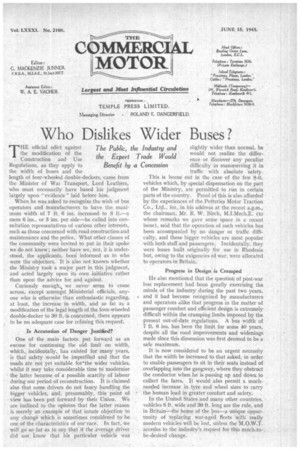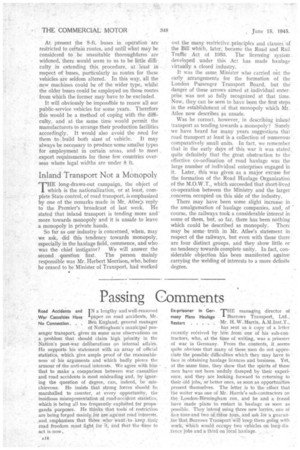Who Dislikes Wider Buses?
Page 17

Page 18

If you've noticed an error in this article please click here to report it so we can fix it.
.THE official edict against the modification of the Construction and Use Regulations, as they apply to the width of buses and the length of four-wheeied double-deckers, came from the Minister of War Transport, Lord Leathers, who must necessarily have based his judgment largely upon " evidence 7-laid before him.
When he was asked to recognize the wish of bus. operators and manufacturers to have the maximum width of 7 ft. 6 ins, increased to 8 ft.—a mere ins., or 3 ins, per side—he called into consultation representatives of variOns other interests, such as those concerned with road construction and maintenance and the police. What other classes of the community were, invited to put in their spoke we do not know ; neither have we, nor, it is understood, the applicants, been informed as to who were the objectors. It is also not known whether the Ministry took a major part in this judgment, and acted largely upon its own initiative rather than upon the advice for an against.
Curiously enough,. we never seem to come across, except amongst Ministerial officials, anyone who is otherwise than enthusiastic regarding, at least, the increase in width, and so far as a modification of the legal length of the four-wheeled double-decker to 30 ft. is concerned, .there appears to be no adequate case for refusing this request.
. Is Accusation of Danger Justified?
One of the main factors put forward as an excuse for continuing the old limit on width, which,. incidentally, has existed for many years, is that safety would be imperilled and that the roads are not yet suitable for•the wider vehicles, whilst it may take considerable time tc■ modernize the latter because of a possible scarcity of labour during our period of reconstruction. It is' claimed also that some drivers do not fancy handling the bigger vehicles, and, presumably, this point of view has been put forward by their Union. We are inclined to the opinion, that the latter reason is merely an example of that innate objection to any change which is sometimes considered to be one of the characteristics of our race: In fact, we will go solar as to say that if the average driver did not know that his particular vehicle was slightly wider than normal, he would not realize the differ ence or discover any peculiar difficulty in manceuvring it in traffic with absolute safety.
This is borne out in the case of the few 8-ft. vehicles which, by special dispensation on the part of the Ministry, are permitted to run in certain parts of the country. Proof of this is also afforded by the experiences of the Potteries Motor Traction Co., Ltd., for, in his address at the recent a.g.m., the chairman, Mr. R. W. Birch, M.I.Mech.E. (to whose remarks we gave some space in a recent issue), said that the operation of such vehicles has been accompanied by no danger or traffic difficulty, and these bigger vehicles are most popular with both staff and passengers. Incidentally, they were buses built originally for use in Rhodesia but, owing to the exigencies Of war, were allocated to operators in Britain.
Progress in Design is Cramped He also mentioned that the question of post-war bus replacement had been greatly exercising the minds_ of the industry during the past two years, I and it had become recognized by manufacturersand operators alike that progress in the matter of passenger comfort and efficient design is extremely difficult within the cramping limits imposed by the -present out-of-date regulations. A bus width of 7 ft. 6 ins, has been the limit for some 40 years, despite all the road improvements and widenings made since this dimension was first deemed to be a safe maximum.
It is now considered to be an urgent necessity that the width be increased to that asked, in order to enable passengers to sit in their seats instead of overlapping into the gangway, where they abstract the conductor when he is passing up and down to collect the fares. It would also permit a muchneeded increase in tyre and wheel sizes to carry the human load in greater comfort and safety.
In the United States and many other countries. vehicles 8 ft. wide and 30 ft. long are the rule, and in Britain—the home of the bus—a Unique opportunity of replacing war-aged fleets with really modern vehicles will be lost, unless the M.O.W.T. accedes to the industry's request for this much,tobe-desired change. At present the 8-ft. buses in operation are restricted to certain routes, and until what may be considered to be unsuitable thoroughfares are widened," there would seem to us to be little diffi culty in extending this procedure, at least in respect of buses, particularly as routes for these vehicles are seldom altered. In this way, all the new machines could be of the wider type, whilst the older buses could be employed on those routes from which the former may have to be.excluded.
It will obviously be impossIble to renew all our public-service vehicles for some years. Therefore this would be a method of coping with the difficulty, and at the same time would permit the manufacturers to arrange their production facilities accordingly. It would also avoid the need for them to build both size g of vehicle. It may always be necessary to produce-some smaller types for employment in certain areas, and to meet export requirements for those few countries overseas where legal widths are under 8. ft.
Inland Transport Not a Monopoly
THE long-drawn-out campaign, the object of which is the nationalization, or at least, complete State control, of road transport, is emphasized by one of the remarks made in Mr. Atlee:s reply to the Premier's broadcast of last week. He stated that inland transport is tending more and more towards monopoly and it is unsafe to leave a monopoly in private hands.
So far as our industry is concerned, when, may we ask, did this tendency towards monopoly, especially in the haulage field, commence, and who was the chief instigator? We will answer the second question first. The person mainly responsible was Mr. Herbert Morrison, who, before he ceased to be Minister of Transport, had worked out the many restrictive principles and clauses of the Bill which, later, became the Road and Rail Traffic Act of 1D33. The licensing system developed under this Act has made haulage virtually a closed industry.
It was the same Minister who carried out the early arrangements for the formation of the London Passenger Transport Board, but the danger of these arrows aimed at individual enterprise was not so fully recognized at that time. Now, they can be seen to have been the first steps in the establishment of that monopoly which Mr. Atlee now describes as unsafe.
Was he correct, however, in describing inland transport as tending towards a monopoly? Surely we have heard for many years suggestions that road transport at least is a collection of numerous comparatively small units. In fact, we remember that in the early days of this war it was stated. quite definitely that the great obstruction to the effective co-ordination of road haulage was the large number of individual enterprises engaged in it. Later, this was given as a major excuse for the formation of the Road Haulage Organization of the M.O.W.T., which succeeded that short-lived co-operation between the Ministry and the larger concerns occupied on this side of the industry.
There may have been some slight increase in the amalgamation of haulage companies, and, of course, the railways took a considerable interest in some of them, but, so far, there has been nothing which could be described as monopoly. There may be sometruth in Mr. Atlee's statement in respect of the railways, but even with these there are four distinct groups, and they show little or no tendency towards complete unity. In fact, considerable objection Was been manifested against carrying the welding of interests to a more definite degree.




















































